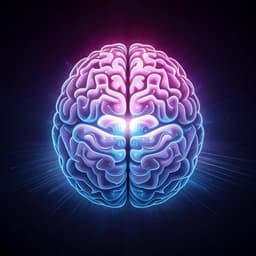
Medicine and Health
Cingulate dynamics track depression recovery with deep brain stimulation
S. Alagapan, K. S. Choi, et al.
Discover groundbreaking insights into treatment-resistant depression through deep brain stimulation of the subcallosal cingulate. This transformative study, conducted by a team of experts including Sankaraleengam Alagapan and Helen S. Mayberg, reveals how innovative biomarkers can personalize recovery trajectories for patients. Learn how 90% of participants showed a robust clinical response in just 24 weeks!
~3 min • Beginner • English
Introduction
Patients with treatment-resistant depression experience diverse, debilitating symptoms and often complex, nonlinear trajectories following subcallosal cingulate deep brain stimulation. In clinical practice, without objective brain-based markers, psychiatrists must infer whether week-to-week symptom fluctuations reflect transient distress or a clinically meaningful change requiring DBS dose adjustment. Gold-standard clinical scales such as HDRS can be confounded by recall bias and situational factors, obscuring core depression changes. This study aims to derive and validate an objective neural biomarker that tracks progression from a depressive ('sick') state to a sustained 'stable response' during chronic SCC DBS, enabling differentiation between transient fluctuations and true relapse or recovery. Leveraging long-term SCC local field potential (LFP) recordings made possible by a sensing-enabled DBS device, along with recent explainable AI (XAI) methods, the authors investigate whether common electrophysiological dynamics can identify clinical state across individuals, how they evolve with chronic stimulation versus acute effects, and how these dynamics relate to structural/functional connectivity in the SCC target network and to behavioral facial expression changes.
Literature Review
Prior SCC DBS studies report durable symptom relief for many TRD patients, yet outcomes and recovery trajectories vary and stimulation programming is empirical. Acute intraoperative/perioperative SCC LFP studies have shown beta-band decreases following brief stimulation exposure, and resting-state/emotional-challenge studies link subgenual cingulate beta oscillations to depressive symptoms. Connectomic targeting emphasizes intersection of specific white matter pathways (cingulum bundle, uncinate fasciculus, forceps minor, frontostriatal fibers) as mediators of therapeutic benefit. However, objective, longitudinal biomarkers to guide clinical decisions during chronic SCC DBS are lacking. Structural white matter integrity and functional connectivity within the SCC network have been implicated in treatment outcomes, suggesting baseline network abnormalities may influence recovery time courses. This work builds on these findings by deriving a common, explainable LFP biomarker during chronic therapy and relating it to multimodal structural, functional, and behavioral measures.
Methodology
Design and participants: Single-site, open-label clinical trial (NCT01984710) in ten adults with treatment-resistant major depressive disorder meeting inclusion criteria (e.g., HDRS-17 ≥ 20; long-standing or recurrent depression; multiple prior treatment failures). All provided informed consent; protocol approved by relevant IRBs and FDA IDE. Weekly independent ratings included HDRS-17 and MADRS. DBS targeting and therapy: Bilateral Medtronic 3387 leads implanted in SCC at the intersection of four white matter pathways (forceps minor, cingulum bundle, uncinate fasciculus, frontostriatal fibers) using a connectomic targeting approach. Stimulation delivered by Activa PC+S sensing-enabled IPG: 130 Hz, 90 µs, monopolar on one contact/hemisphere. Voltage initially 3.5 V for all except P001 at 3.0 V; voltage increases of 0.5 V permitted based on clinical judgment during 24-week observation phase. Electrophysiology acquisition: Weekly 15-min lab sessions captured SCC LFPs at 422 Hz. Each session included ~7.5 min with stimulation ON and ~7.5 min OFF; only OFF data analyzed to avoid stimulation artifacts. Preprocessing removed first 10 s after offset, spike-like amplifier switching artifacts, and device-related frequency drift (beta/gamma) using robust PCA to isolate neural signals. Features extracted from 10 s segments: spectral power per hemisphere in delta (1–4 Hz), theta (4–8), alpha (8–13), low beta (13–20), high beta (20–30), gamma (30–40); interhemispheric coherence in canonical bands; and phase–amplitude coupling (PAC) between 1.5–3.0 Hz phase and 20–35 Hz amplitude identified from comodulograms. Classification and explainable AI: LFP features were min–max scaled. A neural network classifier (PyTorch) distinguished 'sick' (weeks 1–4) vs 'stable response' (weeks 21–24) states using leave-one-participant-out cross-validation among five typical responders with usable LFP data (of six; four others lacked analyzable data). To obtain interpretable latent biomarkers, a Generative Causal Explainer (GCE) autoencoder framework was trained to compress features into a low-dimensional latent space partitioned into a spectral discriminative component (SDC; 1-D) that causally influences the classifier output and non-discriminative components (SNDCs). Reconstruction fidelity and causality to classifier predictions were validated by component randomization tests and cross-validated reconstruction-based classification. The SDC was transformed into a probability of 'sick' and averaged weekly. Longitudinal trajectories: SDC values were computed for intermediate weeks (5–20) to track progression. A transition to 'stable response' was defined as the first of two consecutive weeks below a threshold with no subsequent return above threshold for ≥2 weeks (thresholds: HDRS relative score < 0.5; SDC and face classifier probability < 0.35 in comparisons between these two measures). Imaging analyses: Preoperative MRI included T1-weighted, resting-state fMRI (eyes open), and diffusion-weighted imaging (DWI) on 3 T Siemens scanners. Standard FSL/AFNI preprocessing was applied; resting-state SCC seed connectivity maps were generated and Fisher z-transformed. DWI processing yielded FA, radial and axial diffusivity; TBSS created a white matter skeleton (FA threshold 0.2). A common activation pathway mask (tracts through VTA at chronic settings via StimVision and Xtract) constrained tract-specific analyses. Spearman correlations assessed relationships between white matter integrity measures and SDC-defined transition times; additional correlations related FA and SCC–midcingulate connectivity to depression history across nine responders. Facial expression analysis: Weekly clinical interview videos (~30 min; 30 fps) were processed with OpenFace to derive action units, gaze, head pose, and landmarks. Second-order statistical and kinematic features were computed, yielding 1,073 features per 5-min window. For each participant, a random forest classifier was trained to distinguish 'sick' (weeks 1–4) vs 'stable response' (weeks 21–24) using selected features (paired t-test feature selection, SMOTE for class imbalance, 10-fold CV). The per-week classifier probability of 'sick' for weeks 5–20 served as the face classifier output. Statistics: One-sided Wilcoxon signed-rank tests assessed within-subject changes (small sample, directional hypotheses). ROC/AUC quantified classifier performance and agreement between SDC-derived and HDRS-derived states. Linear mixed models related SDC to HDRS and to face classifier outputs (participant as random effect). Spearman correlations tested imaging–behavior associations. Significance was set at P < 0.05 (uncorrected for correlations).
Key Findings
- Clinical outcomes: Across 10 participants, mean HDRS-17 decreased from 22.3 (SD 1.64) at baseline to 7.3 (SD 3.62) at 24 weeks. 9/10 (90%) were responders (>50% HDRS-17 decrease) and 7/10 (70%) remitted (HDRS-17 < 8).
- LFP-based classifier: In five typical responders with analyzable LFPs, a neural network distinguished 'sick' (weeks 1–4) vs 'stable response' (weeks 21–24) with AUROC 0.87 ± 0.09 (leave-one-participant-out CV).
- Spectral discriminative component (SDC): XAI-derived SDC captured joint spectral changes distinguishing states, with largest increases from 'sick' to 'stable' in left alpha (8–13 Hz), left low beta (13–20 Hz), left high beta (20–30 Hz), right high beta (20–30 Hz), and right gamma (30–40 Hz). SDC-based weekly state predicted HDRS-defined state with AUC 0.94 ± 0.036 (>90% agreement).
- Acute vs chronic beta dynamics: Relative to the post-surgery, stimulation-off baseline, left low beta power decreased early (weeks 1–4) with stimulation (P = 0.031) but increased late (weeks 21–24) (P = 0.031); early vs late difference significant (P = 0.031). Left high beta showed a similar early decrease/late increase pattern (early and late changes individually P = 0.062; early vs late difference P = 0.031). This contrasts prior acute studies showing post-stimulation beta decreases, indicating distinct long-term adaptations.
- Dose sensitivity: Increases in stimulation voltage were followed by SDC decreases the next week (mean change −0.177 ± 0.111; P = 0.039), signaling progression toward 'well'; corresponding HDRS-17 changes were not consistently significant (P = 0.151). Changes after dose increases differed from random weeks without dose changes (P = 0.034).
- Relapse prediction (held-out patient P001): SDC trained on other participants crossed relapse threshold ~5 weeks before clinical relapse detected by HDRS-17, demonstrating potential prospective utility. SDC responded to dose increases, stabilizing after multiple adjustments.
- Imaging correlates: Longer SDC-defined time to stable response correlated with greater white matter microstructural abnormalities (lower FA and higher radial/axial diffusivity) within target-network tracts connecting SCC to vmF, anterior hippocampus, insula, dACC, and PCC (P < 0.05). dACC FA correlated with SCC–midcingulate functional connectivity and both measures negatively correlated with number of lifetime depressive episodes (n = 9; P < 0.05), linking structural/functional deficits with disease severity.
- Facial expression: Individualized random forest classifiers distinguished 'sick' vs 'stable response' using video-derived features with AUROC 0.95 ± 0.05. Face classifier output correlated with SDC over weeks 5–20 (linear mixed model F(1.00, 51.74) = 6.54, P = 0.01), and transition weeks from 'sick' to 'stable' were concordant between face output and SDC (Kendall’s tau = 0.89, P = 0.037).
Discussion
The study addresses the need for objective, brain-based markers to guide SCC DBS management in TRD by deriving an explainable LFP biomarker (SDC) that generalizes across patients and accurately identifies depressive versus stable recovery states. The SDC tracks individual recovery trajectories, responds acutely to dose adjustments, and can anticipate clinical relapse earlier than standardized interviews. The longitudinal electrophysiological findings reveal differential acute versus chronic effects in the SCC, notably an early beta desynchronization followed by a sustained beta increase with continued stimulation, suggesting stimulation-induced plasticity and establishment of a new homeostatic state underlying stable recovery. Multimodal associations indicate that baseline white matter microstructural deficits and functional connectivity abnormalities within the SCC-target network are linked to slower stabilization and greater lifetime disease burden, aligning with a structural-functional disease model. Objective facial expression changes corroborate SDC-derived state transitions, reflecting behavioral normalization in concert with neural recovery. Collectively, these results advance personalized SCC DBS by providing an actionable biomarker to distinguish transient distress from relapse, inform dose adjustments, and integrate structural/functional context, supporting a clinician-in-the-loop approach and motivating further work on network plasticity mechanisms in depression.
Conclusion
This work demonstrates a common, explainable LFP biomarker (SDC) that robustly tracks depression state and recovery during chronic SCC DBS, differentiates acute fluctuations from sustained improvement, responds to stimulation adjustments, and predicts relapse ahead of clinical scales. The biomarker’s longitudinal beta-band dynamics point to distinct acute versus chronic network adaptations, consistent with stimulation-induced plasticity and re-establishment of stable network function. Structural and functional abnormalities in the targeted white matter network correlate with recovery timing and depression history, and facial expression changes provide convergent behavioral validation. Future directions include prospective validation in independent cohorts, integration into clinician-in-the-loop DBS programming, higher-frequency sampling to model momentary distress signatures, exploration of adjunct rehabilitative interventions, and longitudinal MRI with MRI-compatible IPGs to directly track network remodeling.
Limitations
LFP analyses were feasible in only 6 of 10 participants due to prototype device/data artifacts and protocol changes. Biomarker estimation used stimulation-off recordings to avoid artifacts; although brief interruptions were well tolerated, on-stimulation biomarkers would be more convenient. The study did not explicitly model acute moment-to-moment distress, limiting specificity for short-term mood/anxiety fluctuations. Analyses were retrospective with a small cohort, leaving open questions about optimal timing and rules for stimulation adjustments and adjunct therapies. Statistical power was limited, and correlation analyses used uncorrected thresholds.
Related Publications
Explore these studies to deepen your understanding of the subject.







